Liverpool were abject at best on Sunday against Tottenham Hotspur, and duly suffered a 4-1 thrashing. Any hope of a return to form after the 7-0 victory over Maribor in the Champions League quickly dissipated at Wembley, and the Reds are now officially in another wretched run of form, their second malaise in this calendar year.
Everything still remains in the balance, with Liverpool top of their Champions League group and only three points behind fourth place.
Yet something has to change, and quickly, otherwise this season will quickly follow a repeat pattern that the Reds have suffered during their 27-year Premier League title drought: have a promising campaign that suggests the club is close to winning the biggest prizes in football, then suffer a poor summer and regress in the following season and beyond, before rebuilding and starting the cycle all over again.
The summers of 2002, 2009 and 2014 immediately come to mind, although with regards to 2009, issues began to arise the previous summer between Rafael Benitez, Liverpool’s then-owners Tom Hicks and George Gillett, and Xabi Alonso (as Benitez tried to sign Gareth Barry from Aston Villa).
Regardless, in all three cases Liverpool had a great chance to fill in the missing piece of the jigsaw, building on a strong squad with world-class players who were at their peak. Yet the right reinforcements never arrived, while key players were often sold (either because they wanted to leave, because of financial pressures, or both).
In 2002, Gerard Houllier simply bought the wrong players, with El-Hadji Diouf, Salif Diao and Bruno Cheyrou going down into the wrong places of the Anfield legend. Declining to sign Nicolas Anelka on a permanent deal did not help Houllier either.
Liverpool dropped from second to fifth as a result and set the stage for Houllier’s demise, despite winning the League Cup in 2003 and guiding the Reds to a top four finish in the following season.
The 2008/09 Liverpool side was arguably the club’s strongest in the Premier League era, but the squad was thin and needed depth. Benitez did not help matters by selling the likes of Robbie Keane and alienating Xabi Alonso by attempting to sell the Spaniard to fund a move for Gareth Barry.
However, most of Benitez’s actions were the result of tough decisions that he had to make because of the tight restrictions suddenly imposed by Hicks and Gillett, who quickly revealed that they were not the owners everyone on the red half of Merseyside had hoped for.
Having funded the 2007 summer spree (including Fernando Torres and Javier Mascherano) with loans and not their own finances, Benitez then had to sell-to-buy for the future.
Some of Benitez’s decisions were poor, with Alonso’s departure in 2009 a huge factor towards his own a year later, but Benitez should not have had to make these calls.
Barry should have been signed, David Silva should have been signed and proper replacements should have been sought for the likes of Sami Hyypia, only for Liverpool to sign cheaper, and poorer versions, such as Sotirios Kyrgiakos. The squad was not strengthened – in fact both the starting eleven and the small depth that did exist was weakened by Hicks and Gillett’s poor ownership, which almost resulted in administration for the club in 2010.
Losing Alonso, signing low-cost, low-quality players – it was not a recipe for success, and the Reds subsequently slumped from second in 2008/09 to seventh in 2009/10.
The summer of 2014 was highlighted by the inevitable loss of Luis Suarez to Barcelona, and the awful attempt at both replacing him and strengthening the squad.
After mocking Tottenham’s attempt to undertake a similar task in 2013 when replacing Gareth Bale, Brendan Rodgers presided over one of the club’s worst ever transfer windows, especially given the financial outlay.
Lazar Markovic (technically still at the club), Rickie Lambert and Mario Balotelli were expensive failures, while Javi Manquillo continued Rodgers’ poor record with loan signings (see Aly Cissokho and Victor Moses) and huge question marks remain over Alberto Moreno, Divock Origi and especially Dejan Lovren.
Emre Can and Adam Lallana can be considered the only successes from that summer, and no one would describe the duo as world-class.
Once again Liverpool experienced an inevitable decline which Jurgen Klopp has been attempting to reverse ever since, which leads to the summer just gone.
2017 was more a missed opportunity than a poor summer, with no centre-back, goalkeeper or elite left-back signed, while Liverpool still need a clinical goalscorer, who compares with rivals such as Harry Kane and Sergio Aguero, and their elite midfield signing – RB Leipzig’s Naby Keita – will not arrive until January at the earliest.
Consequently, only one of the back seven that played on Sunday – the goalkeeper, defence and two deeper midfielders – was signed by Klopp. That was Joel Matip, who was a free transfer.
Surely now, after the Wembley debacle, Klopp must recognize the need to change that statistic, and lower his trust in players from previous regimes. If not, then 2017 may go down as another year where Liverpool moved further from, not closer to, their gloriously successful and seemingly ancient past.



